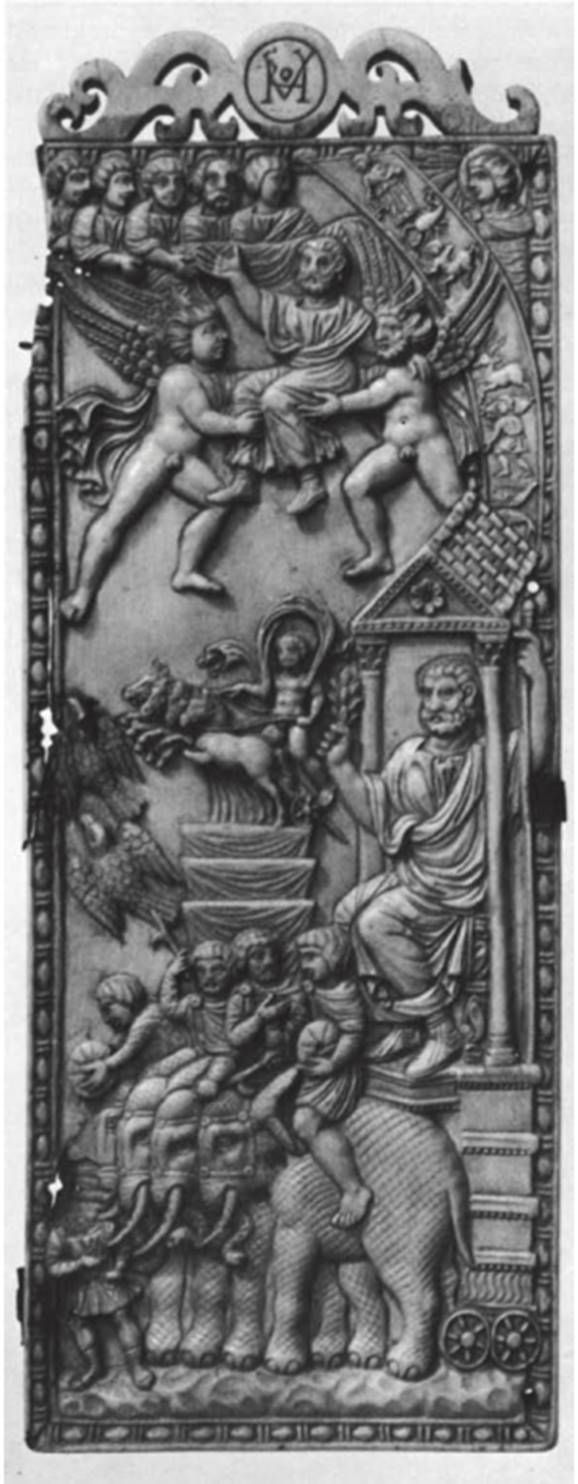Diptych leaf with consecration of a deceased emperor. Rome (?), 2nd quarter 5th century. Ivory
From the left side of the plaque, part of the upper edge is missing; the head of one of the eagles and the head of the man in the lower left corner have been chipped off, as well as a segment of the symmetrically cut openwork volute on top.
Within a bead-and-reel frame, several moments of a consecration ceremony are taking place simultaneously. A carriage pulled by an honorific team of four elephants is led by a man on foot; on the carriage, the image of a seated emperor is seen within a slender columned aedicula below a gabled roof. He holds up a laurel branch in his right hand and supports a staff with his left. On top of each bridled elephant rides a mahout, differentiated as to age. Beyond is a draped funeral pyre with a youthful god in a quadriga on top. Two eagles emerge from it and fly heavenward, signifying the apotheosis of two people, the other possibly represented on the lost leaf. Above, the emperor's spirit is carried up by two winged wind genii toward a cloud-banked heaven, where he is greeted by five deities or deified ancestors. Half of the zodiac is shown in an arc to the right: Libra, Scorpio, Sagittarius, Capricorn, Aquarius, and Pisces; a profile bust of Helios, with nimbus and rays, is in the upper right corner.

The carving is not only a detailed record of the event but, in the tradition of Roman historical reliefs, also of the participants and accessories: all heads are individualized, a conventional reticulate pattern is used on the elephants, and the throne and zodiacal figures, on the smallest scale, are fastidiously executed. The ambiguous spatial relationships are visually resolved by simple overlappings from bottom to top; and the narrative sequence of the ceremony is organized with maximum effect, using relative sizes and positions of the figures and scenes to report the event.
The style and high quality relate this piece to a number of other well-known ivories (nos. 84, 453) made during the first half of the fifth century. The piece has been attributed to a north Italian atelier (Wessel, 1948-1949, pp. 148-149), but a Roman origin cannot be conclusively excluded. The city apparently remained prominent as an artistic center in the first half of the fifth century, contributing the mosaics in Sta. Maria Maggiore (no. 420) and probably other works (e.g., nos. 203, 438, 452) attributed to Roman ateliers.
Identifications of the deified pagan emperor include Antoninus Pius, Constantius Chlorus, and Julian; no date in the first half of the fifth century, however, provides a definitive historical connection to any of these imperial figures—most widely accepted is the hundredth anniversary, in 431, of Julian's birth.
The monogram, variously interpreted, has been deciphered to read symmachorum (Weigand, 1937), relating it to one family responsible for the Symmachi diptych (no. 166), placing the plaque within the retrospective milieu of the old Roman aristocracy.
Formerly in the Gherardesca collection, Florence; bought by the British Museum in 1867. Bibliography: Weigand, 1937; Wessel, 1948-1949; Calza, 1972, nos. 73, 275; Volbach, 1976, no. 56.
Date added: 2025-07-10; views: 45;
